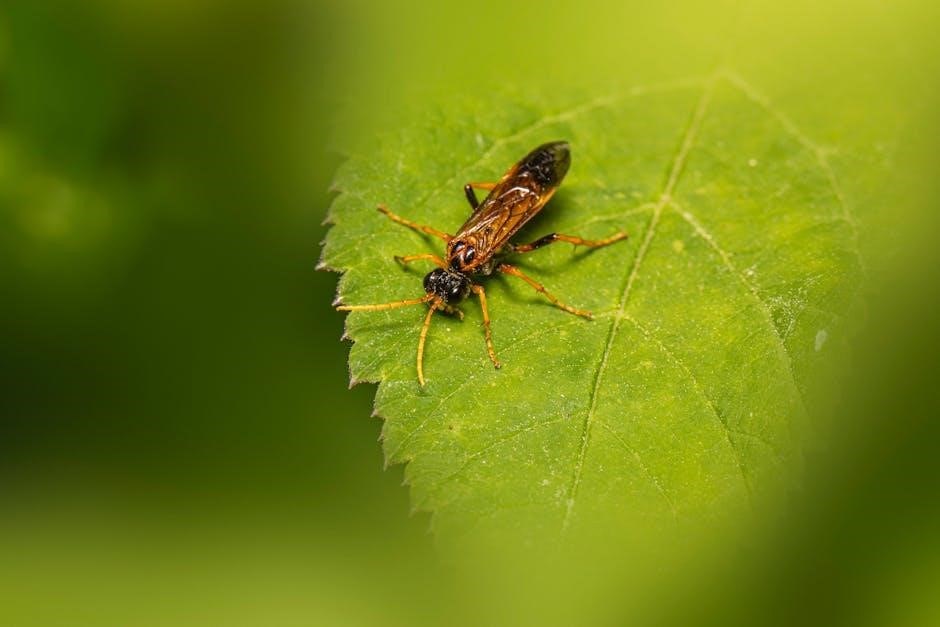Identifying insect eggs in your home is crucial for early detection of potential pest infestations․ Recognizing these tiny signs can help you take proactive steps to maintain a pest-free environment and prevent further damage․
The Importance of Identifying Insect Eggs
Identifying insect eggs is essential for understanding potential pest infestations and their risks․ Insect eggs can signify the start of a pest lifecycle, leading to property damage or health issues․ For instance, cockroach eggs can indicate a growing infestation, while termite eggs may signal structural damage․ Bed bug eggs, often hidden in cracks, can lead to severe bites and allergies․ Early identification allows for timely intervention, preventing eggs from hatching and reducing the need for extensive treatments․ Recognizing insect eggs also helps in targeting the root of the problem, ensuring effective pest control measures․ By identifying eggs, homeowners can address issues before they escalate, protecting their health, belongings, and home integrity․ This proactive approach is key to maintaining a safe and pest-free living environment․

Common Characteristics of House Insect Eggs

Insect eggs vary in color, shape, and size, but often share traits like oval or cylindrical forms and smooth or textured surfaces, aiding identification and species distinction․
Color of Insect Eggs
Insect eggs display a wide range of colors, including white, yellow, green, brown, and even spotted or patterned variations․ These colors often serve as camouflage, blending with their surroundings to avoid detection․ For instance, bed bug eggs are typically white, while cockroach eggs may appear dark brown or black․ Some species, like certain beetles, may have eggs with distinctive markings or shades that help them merge into their environment․ The coloration can also vary depending on the species’ habitat and evolutionary adaptations․ Observing the color is a key step in identifying insect eggs, as it provides valuable clues about the type of pest and its life cycle․ This characteristic, combined with shape and size, aids in accurate identification and targeted pest control measures․
Shape and Size of Insect Eggs
The shape and size of insect eggs vary significantly across species, providing essential clues for identification․ Cockroach eggs are often cylindrical and encased in a protective ootheca, while bed bug eggs are tiny, oval, and about the size of a pinhead․ Fly eggs resemble small grains of rice and are usually cylindrical, whereas termite eggs are small, white, and oval-shaped, typically found in clusters within nests․ Beetle eggs can be round or oval, varying in size and color depending on the species․ The shape and size of these eggs are adaptations to their environment and reproductive strategies, making them unique identifiers․ Examining these characteristics closely can help determine the type of insect and inform effective pest control actions․
Texture and Surface Features
The texture and surface features of insect eggs are crucial for identification, as they vary significantly among species․ Cockroach eggs, for instance, are enclosed in a leathery, protective ootheca, while bed bug eggs are covered in a sticky substance that helps them adhere to surfaces․ Termite eggs are smooth and white, often clustered together in nests․ Fly eggs may appear slightly ridged or segmented, and beetle eggs can have a smooth or slightly textured surface․ These unique textures serve as protective mechanisms and aid in camouflage․ Observing these details under magnification can provide valuable insights into the type of insect and its reproductive habits, helping to tailor effective pest control strategies․

Common House Insect Eggs
Common house insect eggs include cockroach, bed bug, termite, fly, beetle, and wasp or hornet eggs․ Each type has unique characteristics, aiding in identification and targeted pest control strategies․
Cockroach Eggs
Cockroach eggs are typically enclosed in a protective casing called an ootheca, which is brown or black in color and shaped like a capsule․ Each ootheca contains multiple eggs, ranging from 10 to 30, depending on the species․ These casings are often found in dark, hidden areas such as under appliances, behind furniture, or near food sources․ Cockroach eggs are highly resilient and can survive in various environmental conditions․ The ootheca is difficult to destroy, as it shields the eggs from insecticides and physical damage․ Identifying cockroach eggs early is crucial, as they can hatch into nymphs within weeks, leading to a rapid infestation․ Regular cleaning and inspections are key to preventing cockroach egg growth in homes․
Bed Bug Eggs
Bed bug eggs are tiny, white, and oval-shaped, measuring approximately 1 millimeter in length; They are often found in clusters within cracks and crevices, such as mattress seams, bed frames, and behind headboards․ Female bed bugs lay their eggs in these hidden spots, where they adhere to surfaces using a sticky substance․ The eggs hatch within a week, developing into nymphs that resemble smaller versions of adult bed bugs․ Early identification is critical, as bed bugs can quickly infest an entire room․ Regular inspections of bedding and furniture are essential for detecting these eggs before an infestation becomes severe․ If left unchecked, bed bug eggs can lead to significant discomfort and health concerns, emphasizing the importance of prompt action upon discovery․
Termite Eggs
Termite eggs are small, white, and oval-shaped, typically laid in clusters within the colony’s nest․ They are often hidden in wood or soil, making them difficult to spot․ Female termites lay eggs in protected areas, such as damaged wood or inside mud tubes․ The eggs hatch into larvae, which develop into workers, soldiers, or future reproductives․ Identifying termite eggs requires inspecting areas like wooden structures, especially those showing signs of damage or decay․ While the eggs themselves are hard to find, their presence indicates an active termite infestation, which can lead to significant structural damage if left untreated․ Regular inspections of wood and soil are crucial for early detection and prevention of termite-related issues in homes․
Fly Eggs
Fly eggs are small, white, and cylindrical, often resembling tiny grains of rice․ They are typically laid in clusters near decaying organic matter, such as rotting food, garbage, or manure․ Female flies can lay hundreds of eggs at a time, which hatch within 24 hours into larvae, known as maggots․ These eggs are commonly found in moist, nutrient-rich environments and can quickly lead to infestations if left unchecked․ Identifying fly eggs requires examining areas prone to decay, such as trash bins or compost piles․ Their presence indicates a potential breeding site, making them a key sign of a fly problem․ Regular sanitation and waste management are essential to prevent fly egg infestations in homes․
Beetle Eggs
Beetle eggs are typically small, ranging from white to yellow or brown in color, and are often oval or round in shape․ They are usually laid in hidden or protected areas such as soil, decaying wood, or within plant material․ Some species may lay eggs in clusters, while others deposit them singly․ Beetle eggs can vary in size depending on the species, but they are generally quite tiny, making them difficult to spot without close inspection․ Identifying beetle eggs often requires examining areas where beetles are known to frequent, such as near food sources or in damp environments․ Early detection is crucial, as hatched larvae can cause significant damage to materials like wood or fabric․

Wasp and Hornet Eggs
Wasp and hornet eggs are white and elongated, typically laid in paper-like nests constructed by the insects․ These eggs are often visible during the early stages of nest development and are usually found in sheltered areas such as under eaves, attics, or within wall voids․ The eggs hatch into larvae, which are fed by the adult wasps or hornets․ Identifying these eggs requires examining the nest structure, as they are rarely found outside of it․ The presence of such nests can indicate an infestation, and early detection is key to managing potential stinging insect problems effectively․ The elongated shape and white color are distinctive features that help in identifying these eggs within their nests․

Practical Tips for Insect Egg Identification
Use a magnifying glass to examine egg size, shape, and texture․ Check hidden areas like baseboards and furniture seams․ Compare findings with an identification guide for accurate results․
Using a Magnifying Glass
A magnifying glass is an essential tool for examining insect eggs․ It allows you to observe tiny details like color, shape, and surface patterns that are invisible to the naked eye․ Start by placing the egg on a flat surface under the lens․ Adjust the magnification to get a clear view․ Look for characteristics such as ridges, bumps, or spikes, which can help identify the species․ For example, cockroach eggs may appear smooth and oval, while bed bug eggs are often covered in a sticky substance․ This method is especially useful for distinguishing between similar-looking eggs․ Always handle the eggs gently to avoid damage, as they are delicate and may break easily․ By using a magnifying glass, you can gather the necessary information to compare with identification guides and determine the type of insect․ This step is crucial for effective pest control and prevention․ Regularly inspecting suspicious areas with a magnifying glass can help you detect infestations early, reducing the risk of widespread damage․ Remember, accurate identification is the first step in taking appropriate action against unwanted pests in your home․

Examining Hidden Areas
Inspecting hidden areas is critical for identifying insect eggs in your home․ Many insects, such as bed bugs, cockroaches, and termites, lay their eggs in secluded spots like cracks, crevices, or behind furniture․ Use a flashlight to illuminate dark corners and check areas such as mattress seams, baseboards, and storage spaces․ Pay attention to clusters of tiny eggs or egg cases, which may appear as small, sticky patches or capsules․ For hard-to-reach areas, use a tool like a credit card or knife to gently scrape and examine․ Regularly inspecting these hidden spots can help detect infestations early, allowing you to take action before the problem escalates․ This proactive approach ensures you identify and address potential pest issues promptly and effectively․
Prevention and Control of Insect Eggs
Preventing insect eggs from hatching requires thorough cleaning, using insecticides, and sealing entry points․ Regularly inspect and sanitize areas to eliminate eggs and larvae, ensuring a pest-free environment․
Cleaning and Sanitation
Cleaning and sanitation are essential steps in preventing insect egg infestations․ Regularly sanitizing surfaces, especially in areas prone to moisture or food residue, can disrupt insect breeding cycles․ Vacuuming carpets, rugs, and upholstered furniture helps remove hidden eggs and larvae․ Wipe down surfaces with insecticidal soap or vinegar solutions to deter pests․ Additionally, laundering bedding and storing items in sealed containers can prevent eggs from hatching; Proper waste management is crucial—keep trash bins tightly sealed and dispose of organic waste promptly․ Cleaning also aids in early detection, allowing you to address potential issues before they escalate․ By maintaining a hygienic environment, you can significantly reduce the likelihood of insect eggs taking hold in your home․
Using Insecticides
Using insecticides can effectively control insect eggs and prevent infestations․ However, it’s crucial to select the right products and apply them properly․ Target areas where eggs are commonly found, such as cracks, crevices, and hidden surfaces․ Insect growth regulators (IGRs) are particularly effective, as they prevent eggs from hatching or larvae from developing․ Always follow the product instructions to ensure safety and efficacy․ Combining insecticides with good sanitation practices enhances their effectiveness․ For severe infestations, consider consulting a pest control professional for tailored solutions․ Remember, insecticides are part of a comprehensive strategy to eliminate pests and protect your home from future egg-laying activity․ Proper use ensures a safer and more pest-free environment․ Regular monitoring is essential to maintain control and prevent re-infestation․
Identifying house insect eggs is crucial for early detection and prevention․ By understanding their characteristics and habitats, you can take proactive steps to maintain a healthier, safer living space․
Taking Proactive Steps
Regularly inspecting your home for signs of insect eggs is essential for preventing infestations․ Focus on hidden areas like cracks, crevices, and dark corners where eggs are often laid․ Maintain cleanliness by vacuuming and dusting thoroughly, especially in areas prone to moisture or food spills․ Sealing entry points can prevent insects from accessing your home․ Educate yourself on the types of eggs common in your region to recognize potential threats early․ Monitor for unusual odors, droppings, or shedding skins, as these can indicate pest activity․ By staying vigilant and addressing issues promptly, you can protect your home from pest-related damage and health risks, ensuring a safer and cleaner living environment for everyone․
